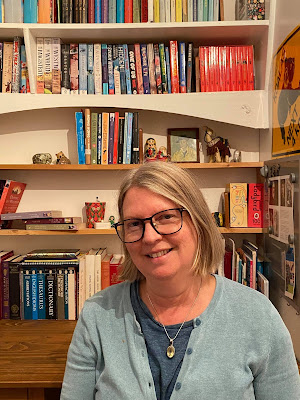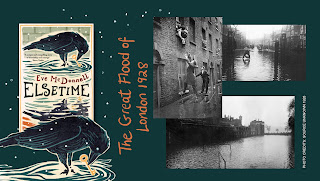The garden of my house in Perth,
Scotland, lost its iron rail fence in World War II – not to an enemy bomb, but
to patriotism. All over the United Kingdom, iron railings got chopped down in
parks and gardens to support the war effort. Here's a link to a newsreel from
1940 showing men collecting railings in a London park!
https://www.britishpathe.com/video/park-railings-for-munitions
The idea was that the iron would be
melted down and used to make ammunition and armour for tanks and ships,
although nobody’s really sure if that happened – there’s a rumour that London’s
iron railings were all dumped in the Thames, and I’ve been told that Perth’s
ended up in landfill on St. Magdalene’s Hill.
Parliament’s Hansard report for 13
July 1943 tells us that somebody wanted to know what was being done with all
that collected iron. Lord Hemingford commented, “It
has been felt that an injustice has been done to a very large number of usually
uncomplaining and patriotic people. This question of the requisitioning of
railings and gates is rather like eczema; it is not very serious, but it is
most confoundedly irritating, and causes a vast amount of bad temper.”
(source: https://api.parliament.uk/historic-hansard/lords/1943/jul/13/requisitioned-railings)
For years, whenever I looked at the
stumps of those railings in my garden wall, I thought of them as my house’s
wartime scars. What I didn’t realize was that World War II took away something
far more tragic from my house than its decorative iron railings. It took away
the boy who’d come of age in that house and who’d still lived there when he
went to war as a young man, the only child of the couple who lived in that
house for forty years. He left my house to go to war and he never came back.

He was a navigator in the Royal Air
Force. He was part of a team of “pathfinders,” a dangerous job in which an
advance aircraft would have to find and mark an attack site for a bomber
squadron, dropping flares in the dark that would light up the enemy target. On 7 Dec. 1940, he and five other crew members
took off from RAF Stradishall in Suffolk in their “Wimpey” – a twin-engined
Vickers Wellington bomber. They flew through atrocious weather in the dark to
Germany, along with two other pathfinder aircraft, to mark the target for a
bombing raid in Dusseldorf. They vanished later that night somewhere over the
North Sea – “Aircraft failed to return,” is what the official reports said.
A Wellington
crew
(source: https://www.lancs.live/news/lancashire-news/lancaster-bomber-brave-daredevils-who-24064051)
Let me tell you about Chick. (His real
name was Charles.) He was a mild-looking young man with dimple in his chin –
his RAF portrait is in black and white, but I think he must have been like
Kate, his mother, short and lightly built, with brown hair, those amused eyes
blue. Robert, Chick’s adoptive father, ran a fishmonger’s shop in Perth, where
Chick helped out, but in 1939, with war looming, he joined the Royal Air Force
as a reservist.
Late in August 1939, just before Germany
invaded Poland, one of Chick’s mates who was also a reservist got his
calling-up papers. The friend and a few others turned up at Chick’s house – MY
house! – at eleven o’clock that night, and they all decided they’d have one
last night on the town before they were called into action. Chick drove them from
Perth to Dundee where, arriving after midnight, they had a couple of drinks and
checked out a couple of all-night coffee stands before heading back to Perth at
about three o’clock in the morning.
That’s when Chick ignored a stop sign,
was spotted by a waiting policeman, and got pulled over for driving under the
influence of alcohol – which apparently he didn’t have a very good head for!
He was fined £10 and given a six month
driving ban. He was contrite and honest about what had happened, and solicitor
who defended him pointed out that it was Chick’s “first time in trouble”! (Source:
Dundee Evening Telegraph, 25 Aug. 1939, page 6).
See my source note there – I got this
story from an old newspaper. It’s available online in the British Newspaper
Archive. Actually, everything I know about Chick – the details of the colour of
his mother’s hair and eyes, the kind of plane he flew, the date of his disappearance,
even his nickname – I dug up by accident simply because I just wanted to know
more about my own old house.
And in the wider sense, isn’t that the
real reason we dig up history – because we want to know more about our own
house, our own city, our own people, our own world? To learn from them, to
connect to them in their strengths and to correct their weaknesses?
I tell this as a coherent story, as if
I knew these people, Chick and his family and friends. But what I know about
them I found through scraps, fragments, puzzle pieces that I’ve fit together:
RAF war graves memorials, stories and police reports and personal columns in
local newspapers, internet queries on ancestry chat boards, wartime bulletins,
photographs, voting records, passenger lists for ships and airplanes.
(source: https://en.wikipedia.org/wiki/Vickers_Wellington#/media/File:See_How_Your_Salvage_Helps_a_Bomber_Art.IWMPST14695.jpg)
Look at that – the scrap metal from
his own fence railings may have become part of the Wellington bomber that Chick
died in.
All my stories begin this way –
finding connections between the ordinary and the extraordinary, between daily
life and drama, between the past and the present. I hope this gives you some inspiration
for finding your own fascinating connections!

Elizabeth Wein is a recreational pilot and the owner of about a thousand maps; flight inspires her young adult novels and non-fiction. Her best-known book, Code Name Verity, was short-listed for the Carnegie award and became a number one New York Times bestseller in 2020. She has published three short novels with Barrington Stoke, including Firebird, which won the Historical Association's Young Quills Award for Historical Fiction in 2019. Look for her latest flight-inspired historical thriller, Stateless, published by Bloomsbury in March 2023.
Visit Elizabeth's website at https://www.elizabethwein.com/
Twitter: @ewein2412
Instagram: ewein2412
The link to my info on the Barrington Stoke site:



























